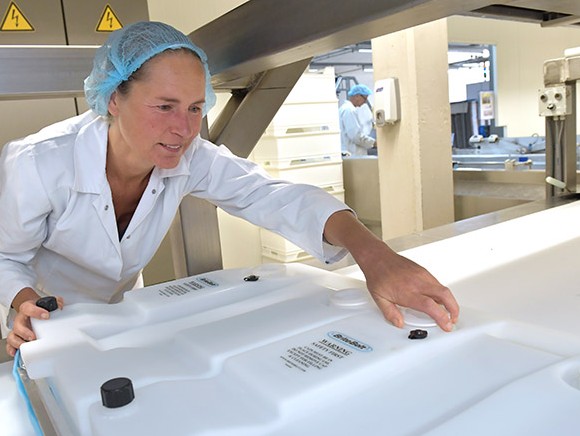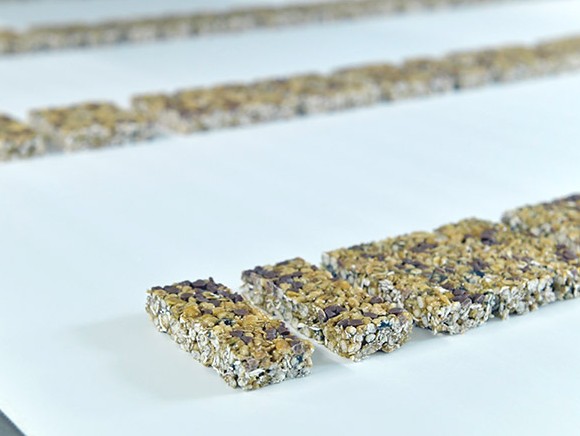
Enzymatic cleaning and an ingenious cleaning system for conveyor systems form the basis for a new approach to cleaning at Ravensbergen Food. The company switched from its former supplier of cleaning agents and materials two and a half years ago, and embarked on a partnership with Qlean-tec instead.
“It all started with a machine that was completely covered in melted chocolate following an incident,” recalls Aat van Kapel, who works in the quality control department at Ravensbergen Food – a manufacturer of biscuits and muesli bars. The company will be celebrating its 85th anniversary this autumn. “A colleague had had good experience with Qlean-tec before, so we called them. We were already looking for a new cleaning partner because our then-supplier wasn’t able to provide the cleaning agents and service we needed.” Maik van Leijden, Account Manager at Qlean-tec, visited the company straight away: “Luckily I had various cleaning materials with me in my car and we were able to resolve the chocolate issue immediately.” Van Kapel: “After that we took our discussions a step further. Qlean-tec provides a total package of cleaning agents and materials, brushes and paper: a one-stop shop.” Even more important, as it turned out later, is the support the company provides in terms of training and advice to ensure the cleaning process is set up optimally.
From a hygiene perspective, the production of a muesli bar is less complex than processing a product such as chicken, explains Angelique Dijkhuizen, who is one of the people responsible for quality at Ravensbergen Food. “Our product composition limits the growth of microorganisms, particularly due to the low Aw value (a measure of water activity, Ed.). The lower the Aw value is, the more difficult it is for microorganisms to form.” The muesli bar production activities start at 4:00 h with making the syrup mixture. This is then combined with the dry ingredients – such as puffed rice, crunchy muesli and oats. The syrup binds everything together and the mixture is then spread out thinly. Once it has cooled, it is cut into bars. The packaging activities start at 6:00 h, based on over 500 units a minute. This continues in two shifts until 22:00 h. Van Kapel: “Most of the mess occurs in the first part of the process when the syrup is still warm and as soon as the mixture is cut into bars. The syrup is sticky, and cutting the bars causes crumbs and other fragments to break off. These bits get left behind on the conveyor, but also find their way onto the rollers, the scrapers and even onto the floor.”
The production operatives have recently started taking care of the cleaning activities themselves, and the contract with the previous supplier of cleaning services has been cancelled. So how are things organised in practice? Dijkhuizen: “Qlean-tec not only provides the cleaning agents and materials, but also supports our employees in using them properly.” Luckily, the scale of the cleaning tasks has been reduced since the introduction of several new techniques. Van Leijden: “One of those is the Brite Belt system, which is a specially designed scrubber unit with a scrub pad for cleaning conveyor belts. It is attached to the moving conveyor and gradually releases the cleaning agent onto the belt. The scrub pad underneath the Brite Belt unit creates the friction necessary to clean the conveyor. That used to be done by hand, but this method is quicker and better too.”
The addition of enzymatic cleaning agents also leads to a more efficient cleaning process and improved results. Van Leijden: “Enzymes react with organic contamination. It’s a form of extremely deep cleaning. They break dirt down into water-soluble residues which can easily be rinsed away. Because this is a pH-neutral method, it’s suitable for virtually every type of material, including stainless steel, aluminium and synthetics. It’s important to do this at the right temperature, though: between 40 and 50 degrees. So this also saves energy because you no longer need to heat the water to 60 degrees or more.” Dijkhuizen: “Following good performance in drains, we’re now testing this cleaning approach in other areas too and the initial results are very promising.” Moreover, the hygiene specialist has given the company new advice for cleaning special machines; tanks are now cleaned using the CIP method, for example, so disassembly is no longer necessary.

Van Leijden: “When defining a new cleaning process we take a project-based approach. This means that we first gain an overview of the current situation, and then we conduct tests based on different cleaning agents, times and temperatures. This results in a fixed step-by-step plan which people are not allowed to deviate from in principle.” The solutions ensure a more efficient cleaning process, which means that the production operatives are able to handle the cleaning tasks alongside their core activities. Dijkhuizen: “We’re still in the midst of the change process so we can’t yet say by how much our efficiency has improved, but one thing we do know is that, when you’re working with an expert, it’s important that you understand one another well: that your questions are answered promptly and that – especially if you’re a manufacturing company – you receive rapid assistance. You can tell that they know what they’re doing at Qlean-tec. They hand the solutions to us on a plate.”
Source: © Cor Salverius/Fotoburo Dijkstra